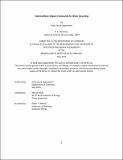Tailoring Metal–Organic Frameworks for Water Harvesting
Author(s)
Oppenheim, Julius Jacob
DownloadThesis PDF (79.73Mb)
Advisor
Dincă, Mircea
Terms of use
Metadata
Show full item recordAbstract
Water sorbents enable technologies that have the potential to mediate water insecurity, meet an increasing energy demand, and push towards sustainability. Metal-organic frameworks (MOFs) are candidate sorbents for such technologies as a direct result of their inherent chemical modularity – facilitating the use of MOF sorbents to adsorb over a large range of relative humidity (RH). However, the underlying structure–function relationships between MOF composition and structure with sorption properties have yet to be explicitly determined. In this thesis, the author explores and defines such structure–function relationships. Chapter 1 introduces the important sorption properties as well as the top performing MOFs and MOF families. In Chapter 2, the author presents a derivation for a relationship between pore composition and the observable sorption parameters (critical RH, maximum gravimetric capacity, and presence of hysteresis loops). Chapter 3 realizes the insights from the preceding chapter to design and synthesize an industrially viable sorbent with high capacity below 30% RH and excellent cycling stability. Chapter 4 further explores these insights, with a focus on the observation that ions contained within the framework pore can greatly increase the hydrophilicity of a framework. Within Chapter 5, the author investigates the relationship between pore hydrophilicity and kinetic hysteresis, finding that kinetic limitations arise in sufficiently hydrophilic frameworks. Chapter 6 explores the driving differences in interaction between a framework and π-backbonding sorbates, for a framework in which the water sorption properties have been previously reported. Within Chapter 7, the author explores an alternative method for post-synthetic modification, whereby chlorine radical abstraction is utilized to reduce a framework, which may be useful for the synthesis of new sorbents.
Date issued
2024-05Department
Massachusetts Institute of Technology. Department of ChemistryPublisher
Massachusetts Institute of Technology